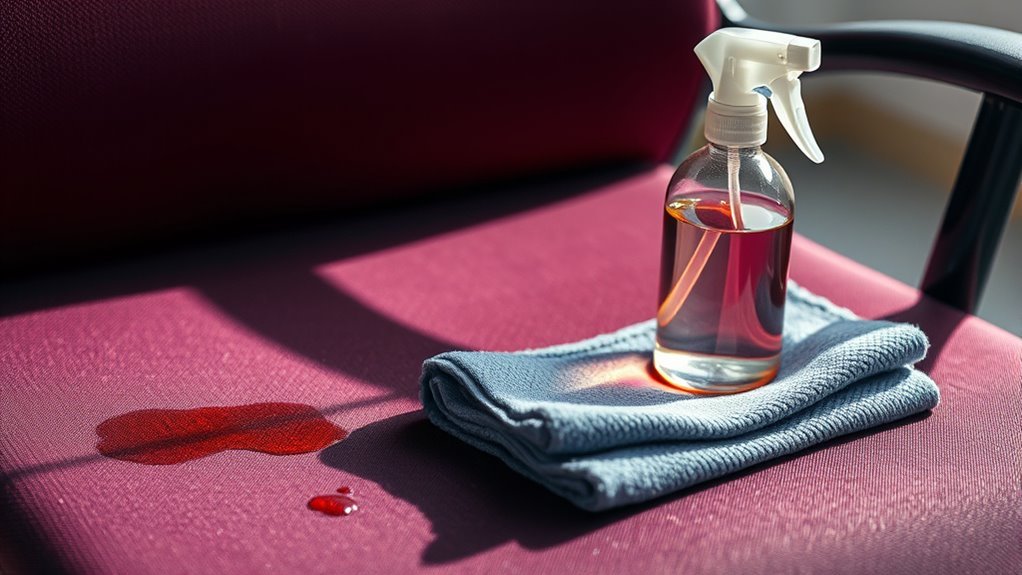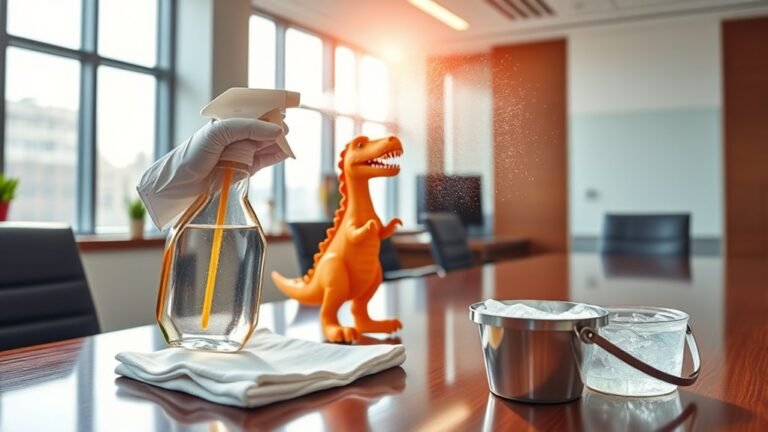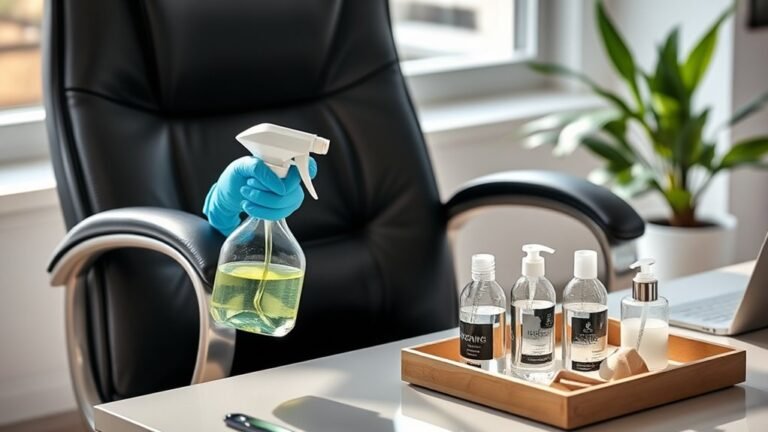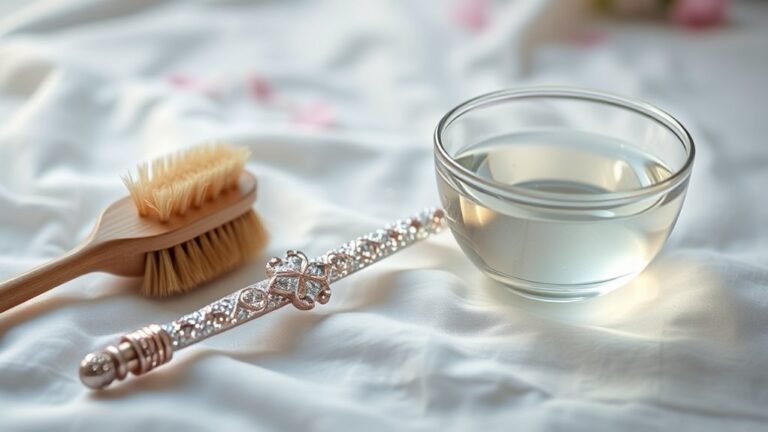Removing Stains Stains From Office Chair
To remove stains from your office chair, first identify the stain type—coffee, ink, food, or grease—and gather gentle cleaners, microfiber cloths, and soft brushes. Blot spills immediately; avoid rubbing to prevent spreading. Use cold water for beverages, rubbing alcohol for ballpoint ink, and mild detergents for fabric. For leather, apply specialized cleaners and condition afterward. Allow proper drying to prevent damage. Following precise care and preventive steps can keep your chair looking fresh and clean longer. Explore more to master these techniques fully.
Identifying Different Types of Stains
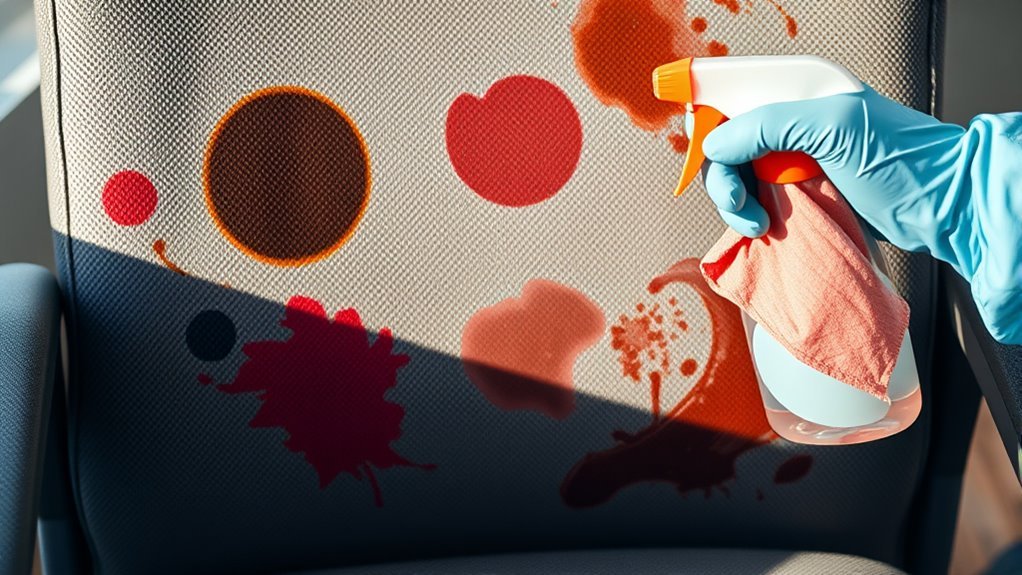
Stains on your office chair can vary widely, so identifying what you’re dealing with is essential before you start cleaning. Pay close attention to stain characteristics like color, texture, and odor. For example, dark, greasy marks often stem from food spills or skin oils, while lighter, sticky residues might indicate beverage stains such as coffee or soda. Ink stains usually appear sharp and vibrant, and water-based stains tend to be pale and waterlogged. Understanding stain causes helps you choose the right cleaning method, ensuring effectiveness without damaging your chair. By carefully evaluating each stain’s origin and appearance, you gain the freedom to address it confidently and efficiently, preventing unnecessary treatments and preserving your chair’s condition long-term. Also, consider the fabric types like leather, mesh, or polyester, as this influences stain behavior and cleaning approaches.
Essential Cleaning Supplies for Office Chairs
Once you’ve pinpointed the type of stain on your office chair, gathering the right cleaning supplies will make the process smoother and more effective. Start with gentle cleaning products suited for your chair’s fabric, such as mild detergents or upholstery cleaners. For tougher marks, select specialized stain removers designed to target specific substances without damaging the material. Have microfiber cloths ready to blot stains without spreading them, and a soft-bristle brush to gently lift dirt. Avoid harsh chemicals that could strip fabric or cause discoloration. Additionally, keep a spray bottle with plain water to rinse cleaning agents safely. By assembling these essential tools, you empower yourself to tackle stains confidently and maintain your chair’s appearance, giving you the freedom to enjoy a clean workspace without hassle. Always test cleaning products on a small, hidden area first to prevent damage or discoloration.
Removing Coffee and Tea Stains
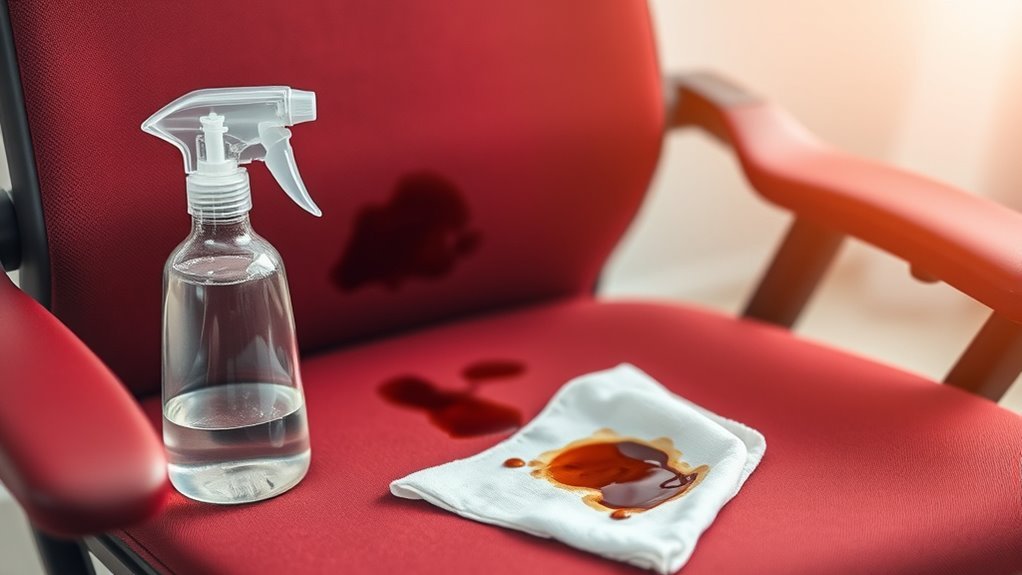
When you spill coffee or tea on your office chair, acting quickly is key to preventing a stubborn stain. You’ll want to use the right cleaning solution tailored to your chair’s material for effective removal. Finally, adopting simple habits can help you avoid future spills and keep your chair looking fresh. Remember to always blot liquid stains gently rather than rubbing to avoid spreading the stain further.
Immediate Stain Treatment
Dealing with coffee or tea spills on your office chair requires swift action to prevent lasting marks. The moment a spill occurs, focus on immediate action to stop the stain from setting. Grab a clean, absorbent cloth or paper towel and gently blot the spill—don’t rub, as that drives the stain deeper. This promotes quick stain absorption, reducing the liquid’s penetration into the fabric. Continue blotting until no more moisture transfers. Next, you can lightly dab the area with cold water to dilute the stain, then blot again to absorb excess moisture. Acting fast and methodically like this guarantees the stain won’t embed, preserving your chair’s appearance and sparing you from tougher cleaning later on.
Effective Cleaning Solutions
After you’ve blotted the spill and prevented it from setting, selecting the right cleaning solution is the next step to fully remove coffee or tea stains from your office chair. Opt for natural cleaners whenever possible to maintain upholstery care without harsh chemicals. Here’s a quick guide:
| Cleaner Type | Application Method | Best For |
|---|---|---|
| Vinegar Solution | Mix 1 part vinegar + 2 parts water, dab gently | Light stains |
| Baking Soda Paste | Mix baking soda with water, apply, then wipe | Strong odors, stains |
| Dish Soap Mix | Few drops in water, sponge lightly | Fresh spills |
| Commercial Upholstery Cleaner | Follow label instructions | Deep, set-in stains |
Using these options methodically helps you restore your chair’s look while embracing freedom from stubborn stains.
Preventing Future Stains
Although spills can happen unexpectedly, taking proactive steps can greatly reduce the risk of future coffee and tea stains on your office chair. You want to protect your investment and maintain a clean workspace with ease. Start by considering stain resistant fabrics when choosing or upgrading your chair. These materials repel liquids, making cleanup simpler. Next, establish a routine for regular maintenance to prevent buildup and spot stains early. Here’s how to stay ahead:
- Use protective covers or washable slipcovers for added defense
- Avoid eating or drinking directly at your desk when possible
- Keep stain remover wipes handy for immediate treatment
- Schedule weekly vacuuming and fabric inspections
Tackling Ink and Marker Stains
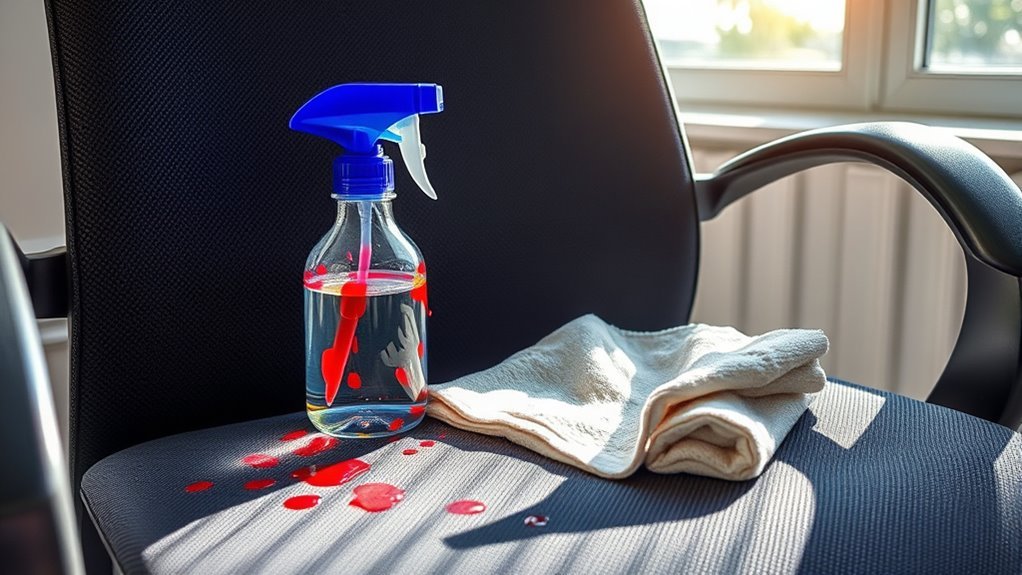
When dealing with ink and marker stains on your office chair, start by identifying the type of ink—whether it’s ballpoint, gel, or permanent marker—as each requires a different approach. You’ll then want to select the appropriate cleaning method, such as using rubbing alcohol for ballpoint ink or a specialized remover for permanent marker. Taking these steps methodically guarantees you tackle the stain effectively without damaging the chair fabric. Additionally, using a stain remover designed for tough marks can help lift stubborn ink stains without harming the fabric.
Identifying Ink Types
How can you effectively remove ink and marker stains without knowing the type of ink involved? Identifying the ink type is essential to choosing the right removal method. Ink varies widely—from ballpoint ink, which is oil-based and tends to sit on the fabric surface, to fountain pen ink, a water-based dye that penetrates fibers deeply. To pinpoint the ink type, observe these signs:
- Color intensity: Ballpoint ink is usually darker and more saturated.
- Drying time: Fountain pen ink dries slower and may smudge.
- Stain texture: Oil-based inks feel slightly sticky; water-based feel smooth.
- Ink source: Check the pen type if available for a direct clue.
Knowing these details frees you to tackle stains efficiently without guesswork.
Effective Cleaning Methods
Since ink and marker stains vary in composition, choosing the right cleaning method depends on the type of ink and fabric of your office chair. For water-based inks, blot gently with a damp cloth and mild detergent. Permanent or oil-based inks often require rubbing alcohol or specialized cleaners. Steam cleaning is excellent for deep fabric stains, offering an upholstery refresh without harsh chemicals.
| Ink Type | Cleaning Method |
|---|---|
| Water-based Ink | Mild detergent, blotting |
| Permanent Ink | Rubbing alcohol, spot clean |
| Marker Stains | Alcohol-based cleaner |
| Fabric Upholstery | Steam cleaning, drying |
Always test cleaners on a hidden spot first. This methodical approach helps you restore your chair’s look while enjoying stain-free freedom.
Dealing With Food and Grease Marks
Although food and grease stains can seem stubborn, you can effectively remove them with the right approach. Start by addressing food spills quickly to prevent setting. For grease removal, avoid harsh scrubbing that can spread the stain. Instead, use a targeted method to lift the mark without damaging your chair.
Food and grease stains may seem tough, but quick, gentle cleaning prevents damage and spreads.
Here’s a simple method to tackle these stains:
- Blot excess food spills gently with a clean cloth.
- Apply a mild detergent mixed with warm water to the stain.
- Use a soft-bristled brush in circular motions for grease removal.
- Rinse with a damp cloth and let the chair air dry.
Additionally, using mild detergent helps preserve the fabric’s quality while effectively cleaning the stains.
Cleaning Fabric vs. Leather Office Chairs
When cleaning your office chair, you’ll find that fabric and leather materials require distinct care techniques to maintain their appearance and durability. Fabric care typically involves gentle vacuuming and spot cleaning with mild detergents, while leather maintenance demands specialized cleaners and conditioners to preserve its texture and prevent cracking. Understanding these differences guarantees you protect your chair without damage. Performing a spot test on a hidden area before full cleaning helps ensure the products used won’t damage the fabric or leather.
| Aspect | Fabric Care |
|---|---|
| Cleaning Method | Vacuum, mild soap, blotting |
| Drying | Air dry, avoid direct heat |
| Maintenance Tip | Use fabric protector spray |
| Aspect | Leather Maintenance |
| Cleaning Method | Leather cleaner, soft cloth |
| Drying | Wipe dry immediately |
| Maintenance Tip | Condition regularly to prevent cracks |
Preventive Tips to Keep Your Chair Stain-Free
To keep your office chair looking its best, you’ll want to adopt a few simple preventive habits that minimize the risk of stains. Effective chair maintenance starts with proactive stain prevention. Here are key tips to help you maintain a clean, fresh chair:
- Use removable, washable covers or protective sprays designed for your chair’s material.
- Avoid eating or drinking near your chair to reduce accidental spills.
- Clean minor dirt or dust regularly with a soft cloth or vacuum to prevent buildup.
- Promptly address any spills with a damp cloth to stop stains from setting.
- Additionally, applying fabric protection sprays can repel stains and spills, enhancing your chair’s longevity.
Frequently Asked Questions
Can I Use Vinegar to Remove Stains Without Damaging the Chair?
Imagine a gentle mist settling on your chair, lifting away stubborn marks. You might wonder about vinegar effectiveness—it’s a natural, budget-friendly option that can work wonders on many fabrics. But before you plunge in, test a hidden spot first; some chair fabric reacts poorly to acids. If it holds up, dilute vinegar with water, apply sparingly, then blot gently. This cautious approach frees you from harsh chemicals while protecting your chair’s look.
How Often Should I Deep Clean My Office Chair?
You should deep clean your office chair every 3 to 6 months, depending on how often you use it. Keeping a regular cleaning frequency helps maintain its appearance and prolongs its life. For maintenance tips, vacuum fabric chairs weekly to prevent dirt buildup and spot-clean spills immediately. If you want your chair to stay fresh and comfortable, sticking to this routine gives you the freedom to focus on work without distractions.
Are There Eco-Friendly Stain Removers Safe for Office Chairs?
Before the dawn of the internet, people relied on eco friendly options made from natural ingredients to tackle stains safely. You can still do that today by choosing stain removers with plant-based components, like vinegar, baking soda, or lemon juice. These are gentle yet effective, ensuring your office chair stays clean without harsh chemicals. Just test any solution on a hidden spot first to protect your chair’s fabric and maintain your workspace freedom.
Can Professional Cleaning Services Remove Old, Set-In Stains?
You can definitely count on professional cleaning services to tackle old, set-in stains. They use advanced stain removal techniques combined with specialized upholstery cleaning methods that go beyond typical DIY efforts. These pros carefully assess the fabric and apply targeted treatments, ensuring deep cleaning without damage. This approach frees you from stubborn marks and restores your chair’s appearance effectively, letting you enjoy a fresh, stain-free workspace without the hassle.
What Should I Do if My Chair Cushion Is Moldy?
As the saying goes, “A stitch in time saves nine.” If your chair cushion is moldy, start by removing it and cleaning it outdoors. Use a mixture of water and white vinegar or a mild detergent to scrub the mold gently. Let it dry completely in sunlight to prevent mold growth. For mold prevention, maintain good airflow and keep your chair dry. Regular chair maintenance guarantees a fresh, mold-free workspace.
